What my daughter's swim school teacher can teach us all about overcoming our fears

Do you remember the moment when you felt that you had learnt how to swim? I don't, but I do know when my daughter felt that she could. It happened Yesterday.
My daughter goes to swim school. Yesterday it was time for the first lesson in the third and last part of the course with the goal of learning to swim by yourself in deep water. In the first and second part, the children stayed in a shallow pool where they can stand, but now it was literally time to move into deep water.
I had warned my daughter about this before but "seeing is believing" and the fear in her eyes when she saw what was to come knew no bounds. Not a single tiny atom in her shaking little body, tightly wrapped in a towel as mental protection, wanted to entertain the thought of jumping into the deep water. With tears in her eyes and a broken father's heart, we approached one of the two swimming instructors to tell it like it was: that my daughter had never been in deep water before and that maybe this wasn't quite the right step for her yet. As it was, there were two other children who were in the same situation as my daughter, which helped them not to feel completely alone in their own fears.
The swim school teacher probably had seen this exact scenario multiple times before and luckily she had other plans than letting us throw in the towel without at least a try.
How the swim teacher had my daughter go from terrified of drowning to a confident deep water swimmer in 15 minutes
Within the next 15 minutes I then witnessed one of the most impressive efforts I have ever seen. From the teacher and from the three children. The teacher made the children go from barely daring to dip one foot in the water in fear of drowning, to all three being able to swim 25 meters by themselves (with a smile on their faces).
How did the teacher get the children to do this? Well, by having them do the following, one step at a time:
- Go down into the water by climbing down to the last step of the bathing ladder (so that the whole body was immersed in the water)
- Release one hand from the bathing ladder and instead hold it on the edge of the pool while the other hand held onto the bathing ladder
- Release also the other hand from the bathing ladder and hold the edge of the pool with both hands
- Do some leg kicks, holding onto the edge of the pool
- Insert a long and narrow floating aid under the stomach and then swim a length themselves with this aid
- Turn their body around, insert the floating aid under the neck and backstroke a length this way
- Let go of the aid completely and swim by themselves by first holding the edge, then letting go of the edge, swimming a few meters and then grabbing the edge when it started to feel a little hard
- Repeat step 7. with longer and longer swimming distances between holding the edge
The pride in my body was almost palpable as I watched my daughter swim a full length with a confident smile on her face. From feelings that almost bore traces of panic in both me and my daughter, the swim school teacher helped my daughter overcome her fear while giving me a valuable lesson.
Let's break down what the teacher actually did to pull this off.
Gradually increasing the perception of skill by smartly balancing the level of perceived challenge
What the teacher did was to help the three children to ultimately find their flow. I.e. place their minds in a feeling of flow thru very smart use of nudging. Let's look at the model below to further explain how she did this:
The flow model
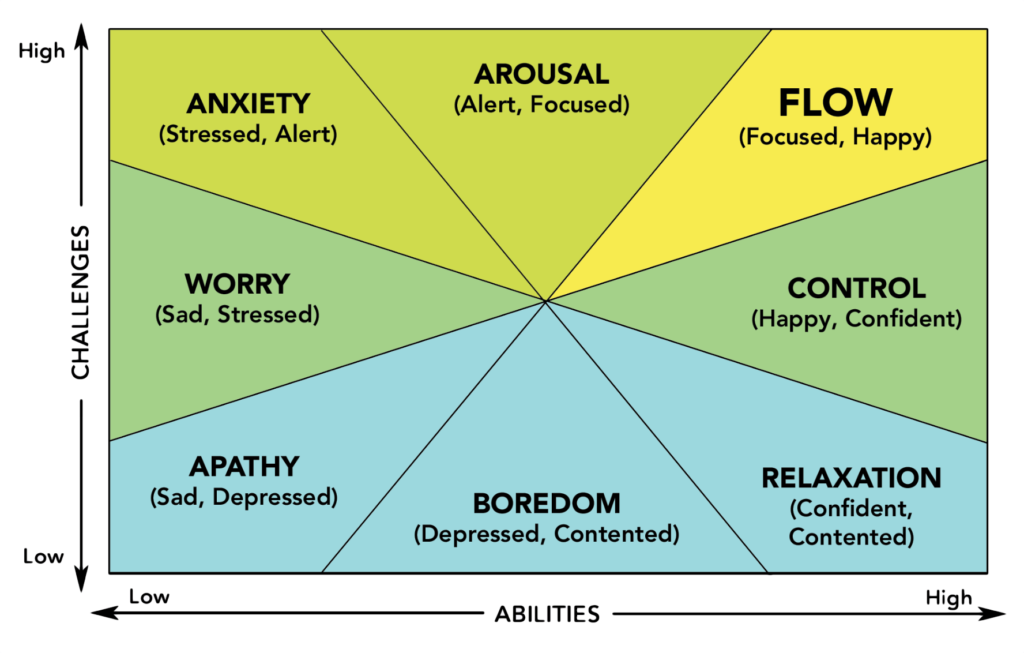
The flow model above explains 8 different states or feelings that we can find ourselves in, as a result of the level of challenge (y-axis) we or someone else place on our shoulders in comparison to the level of abilities (x-axis) we feel that we have, to be able to pull the task at hand off. The feeling of flow is what to strive for. When you're in a flow you find yourself in a mental state of total focus. You are able to completely turn off the outside world from distractions, you are very productive and hours feel like minutes (when looking back, afterwards).
Too much challenge, in comparison to the level of skills/abilities, creates a feeling of worry or anxiety. On the contrary too little challenge, given the skills/abilities at hand, creates a feeling of apathy, boredom or relaxation. The right balance of challenge in comparison to ability gives a feeling of arousal, control or flow.
The flow model applied to my daughter's deep water swimming endeavours
My daughter and her two swim school friends all started off in the top left corner of the chart, i.e. within the area of "Anxiety". The challenge of trying to swim on deep water simple felt completely overwhelming to them when they saw the 2.7m deep pool, given their (own perception of) low ability to do so. What I knew was that my daughter completely underestimated her own ability to swim at this point. She had indeed swum 10-15 meters on her own before, but never in water where she couldn't stand. The challenge of having to simply rely on her own ability to swim to not drown obviously became a bit too much for her at first. But luckily the swim school teacher had a plan to unfold the ability my daughter indeed held:
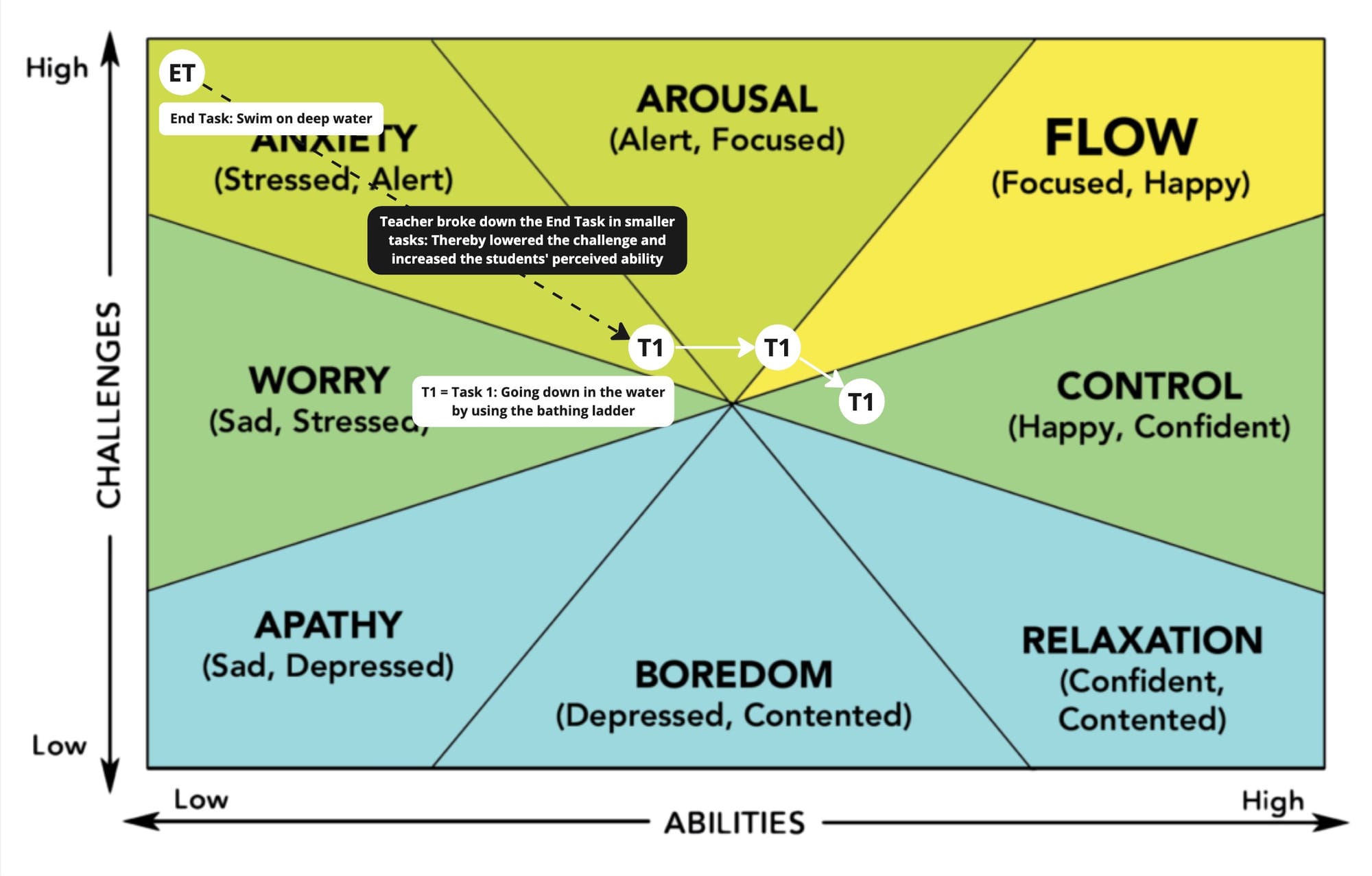
What the teacher did was that she first helped my daughter to strengthen the perception of her own ability, by taking down the level of challenge to a minimum (step 1 - going down in the water by using the bathing ladder). Once the teacher saw that my daughter was able to complete the task and went from a state of being stressed via a state of being focused during the completion of the task to a confident state after having finished it, the teacher raised the bar a bit more:
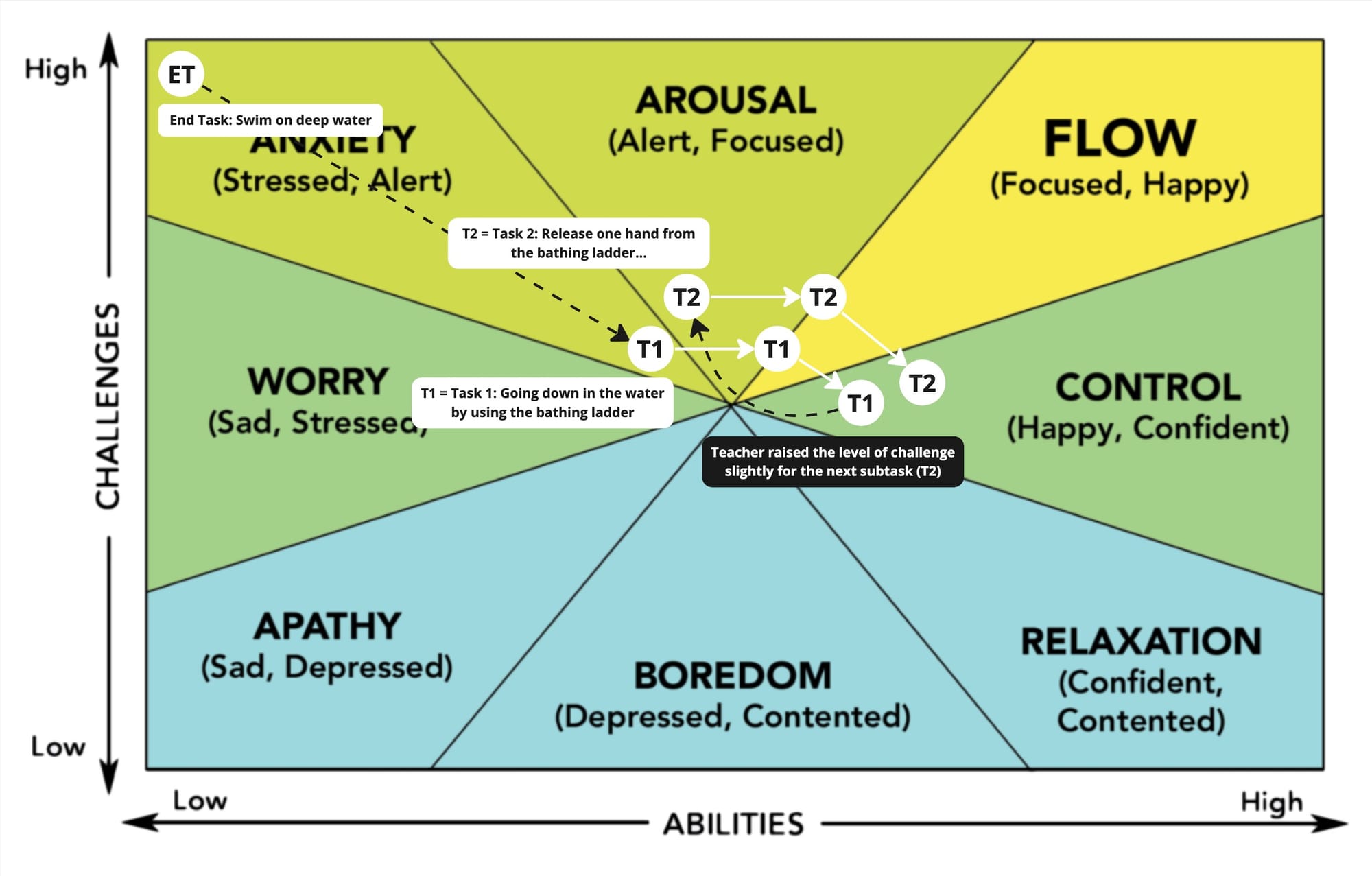
She raised the level of challenge enough for each consecutive task to induce arousal but not anxiety.
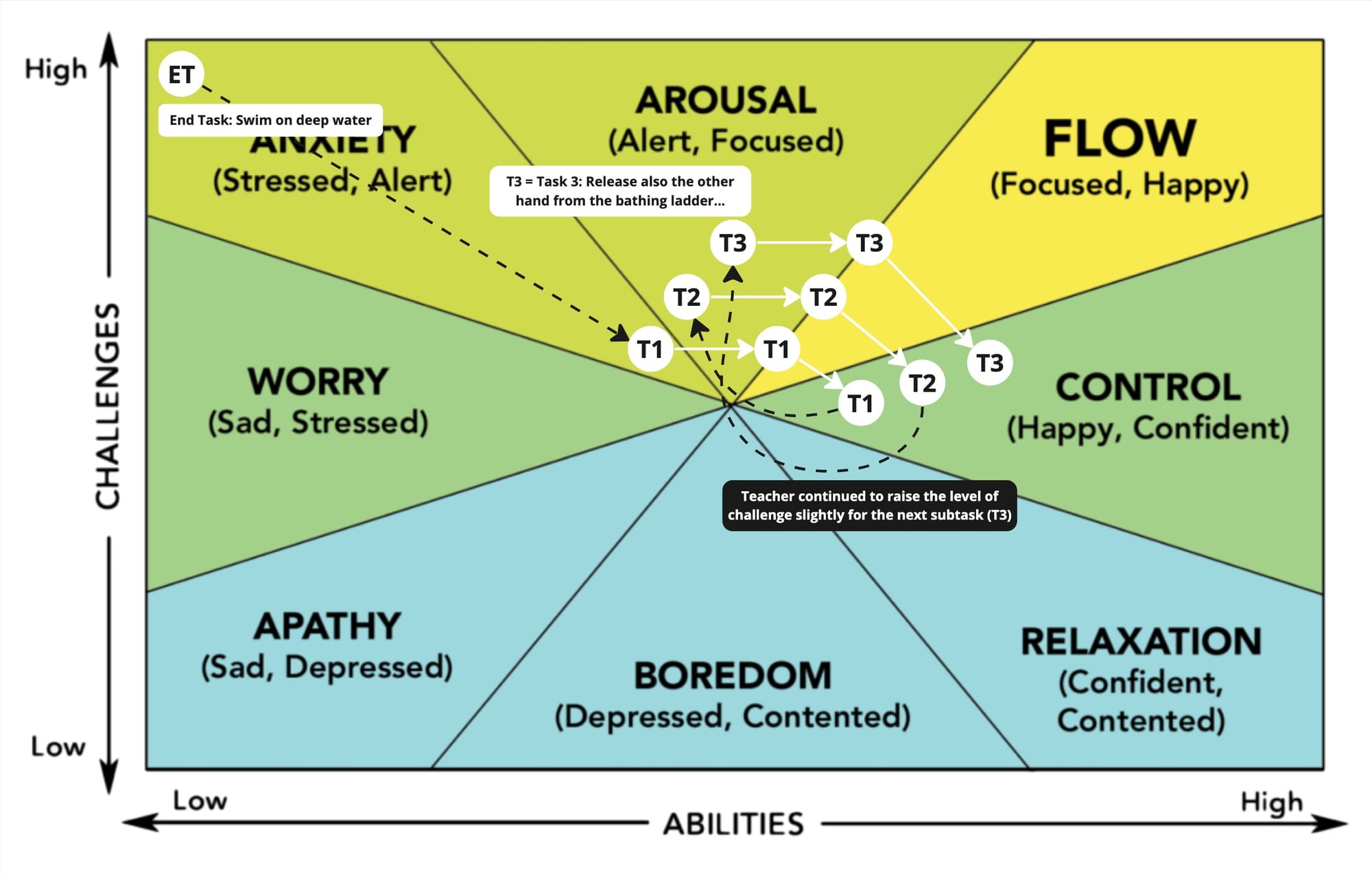
This way the teacher gradually increased the perception of ability in my daughter's mind to a point where swimming herself, only helped by the edge of pool, was challenging enough:
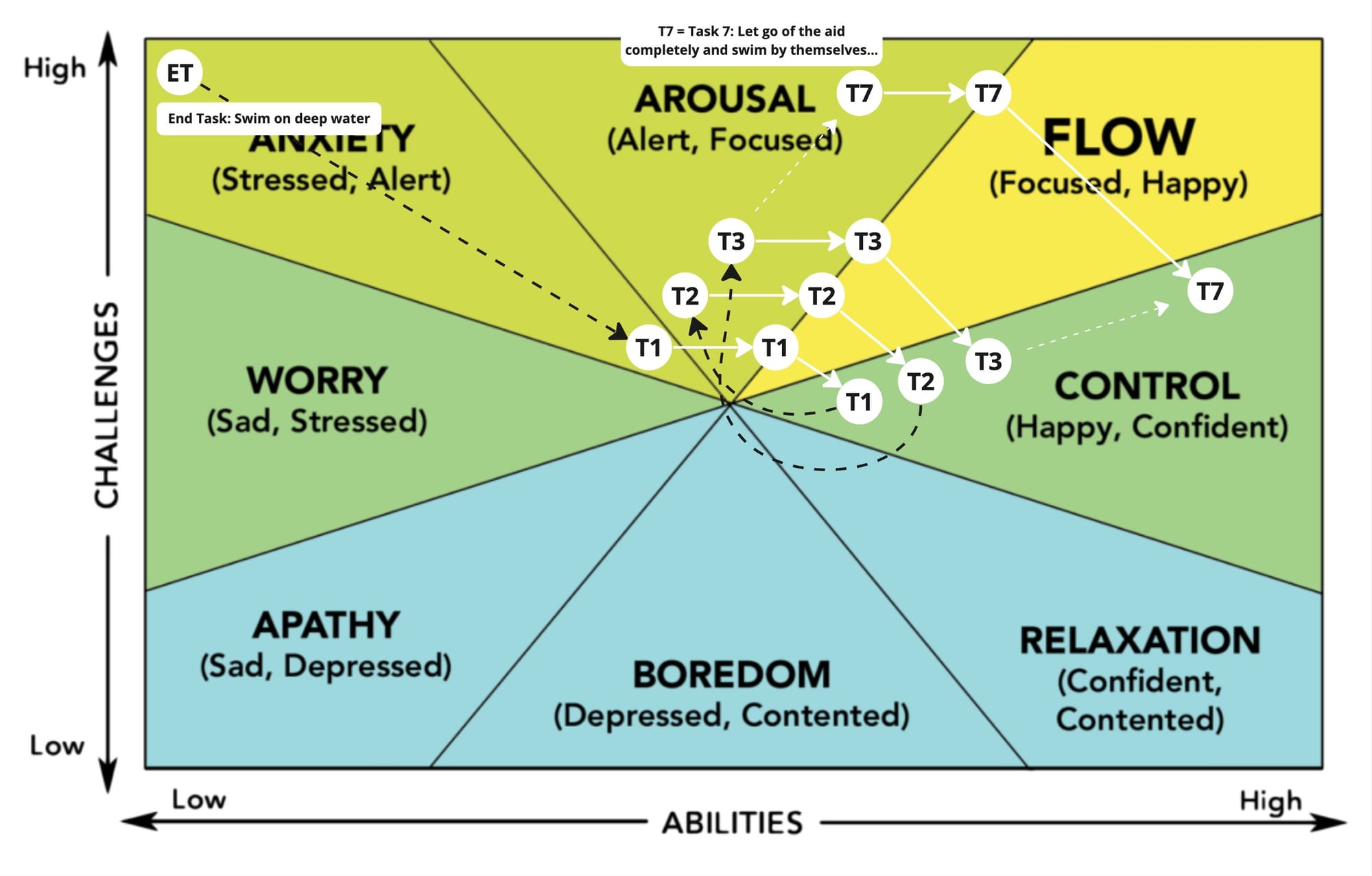
I.e. challenge the students enough to induce arousal (and flow) but not anxiety - which would have stopped them from trying again, hence progressing.
Use the flow model to debug your own feelings and keep yourself on the right track
Next time you feel stressed, worried or overwhelmed about a task handed to you, use the flow model to make sense of why you're feeling this way:
- Is it a lack of ability or skill that makes you feel this way? Can you learn the new skills needed in an efficient enough manner? Can you ask someone else who knows how to do this for help? Or do you need to throw in the towel?
- Is it too much of an ask? Is someone putting too much pressure on you? Or are you putting too much pressure on yourself? Can you bargain a bit to take some pressure of yourself?
- Can the challenge be broken down into smaller tasks that one-by-one feel more doable and hence reduce the feeling of overwhelm? In which order can such broken down tasks be done, to strengthen your abilities enough to sequentially pull all subtasks off?